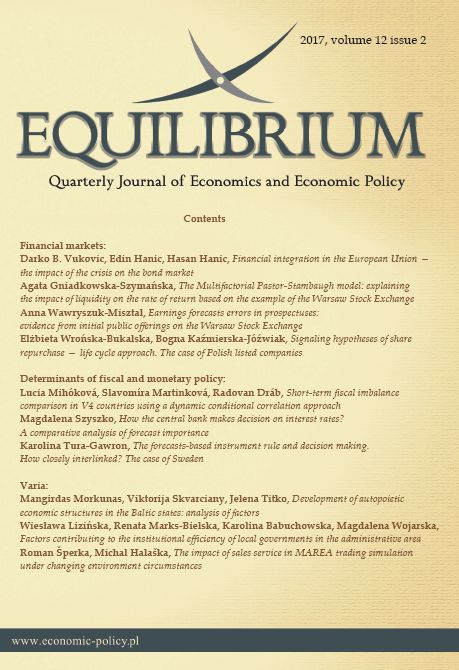THE FORECASTS-BASED INSTRUMENT RULE AND DECISION MAKING. HOW CLOSELY INTERLINKED? THE CASE OF SWEDEN
THE FORECASTS-BASED INSTRUMENT RULE AND DECISION MAKING. HOW CLOSELY INTERLINKED? THE CASE OF SWEDEN
Author(s): Karolina Tura-GawronSubject(s): Economy, National Economy
Published by: Instytut Badań Gospodarczych
Keywords: inflation targeting regime; decision making; inflation forecasts; Taylor rule
Summary/Abstract: Research background: The Central Bank of Sweden declared in years 1999–2006 the implementation of the Svensson’s concept of inflation forecast targeting (IFT). It means that the repo rate decision-making process depends on the inflation fore-casts. The concept evolved from the strict IFT with the decision-making algorithm called ‘the rule of thumb’ to the flexible IFT. Purpose of the article: The aim of the article is to: (1) analyze the influence of the inflation rate and GDP growth rate on the repo rate decisions, (2) analyze the influence of the inflation rate and GDP growth rate forecasts (in two year horizon) on the repo rate decisions in Sweden in years 1999–2006. Methods: The analysis encompasses the repo rates decisions, CPI inflation rate, GDP growth rate, central paths of CPI inflation forecasts and central paths of GDP growth rate forecasts (the mode values) in the two years horizon published by The Central Bank of Sweden in years 1999–2006. The studies are based on the Taylor-type instrument rule and forecast-based Taylor-type instrument rule. The methodology used is multiple linear regression models. Findings & Value added: The Central Bank of Sweden in years 1999–2006 implemented direct inflation forecast targeting (DIFT) rule. The decision-making algorithm was based on the CPI inflation forecasts and the rule of the thumb algorithm. The exact rule of the thumb was as follow: if the inflation forecast, in the two year forecast’s horizon exceeded the infla-tion target by 1 p.p., then the central bank raised the repo rate by 0.4 p.p; if it was below it, then the central bank reduced the repo rate by 0.4 p.p. If the inflation forecast was equal to the inflation target, then the repo rate remained unchanged. The historical repo rates differ from the theoretical estimated rule of the thumb’s repo rates by +/-0.28 p.p.
Journal: Equilibrium. Quarterly Journal of Economics and Economic Policy
- Issue Year: 12/2017
- Issue No: 2
- Page Range: 295-315
- Page Count: 21
- Language: English

